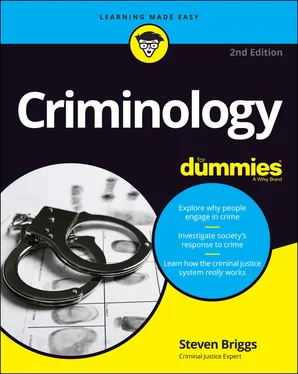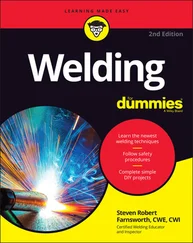I’ve spent most of my career fighting crime at the local, state, and federal levels. I’ve worked with just about every category of law enforcement professional there is, from detectives to probation officers to terrorism experts to judges. And of the thousands of people I’ve known, I can count on one hand the number of people who weren’t committed to something larger than themselves — to serving their fellow human beings. If you’re considering joining these men and women in their fight against crime, or if you’re just curious how the entire criminal justice system works, you’ve picked up the right book.
Here, I explore both the world of crime and society’s response to it. Both topics are fascinating, exciting, and extremely vast. From the gangbanger who sells eight balls of crack on the street corner to the defense attorney fighting for his client’s rights, to the cop who’s just trying to get home to her family, I try to explain what people do and why they do it.
Criminology For Dummies, 2nd Edition, isn’t a textbook (although, if you’re a student, it may help you understand your criminology textbook). It’s meant to give you an insider’s look into the world of crime and criminal justice. Throughout the book, I try to make the concepts and principles of criminology come alive, because nothing is more real than personally experiencing crime.
I try very hard to avoid the use of complex terms in this book. As a prosecutor who has stood in front of numerous juries, I know that the secret to communicating is using straightforward language. Some of the ideas in criminology are complex, but their explanations don’t have to be.
If you’re considering a career in criminal justice, you should know that I don’t pull any punches in this book. If I think a job is tough, I tell you so and give you the reasons why. But I also try to explain the job objectively so you can decide for yourself whether it’s the right move for you.
If you picked up this book simply because you’re fascinated by crime, you may want to set this book on the nightstand next to your collection of works by Ann Rule, Sue Grafton, Patricia Cornwell, James Patterson, or the hundreds of other writers who make crime — at least the fictional kind — fun.
So we’re sure to be on the same page, so to speak, I use the following general conventions throughout the book:
Bold text means that you’re meant to type the text just as it appears in the book. The exception is when you’re working through a steps list: Because each step is bold, the text to type is not bold.
Web addresses appear in monofont. If you’re reading a digital version of this book on a device connected to the Internet, note that you can click the web address to visit that website, like this: www.dummies.com .
Whenever I introduce a word or phrase that may not be familiar to you, I put that word in italics. You can rest assured a definition or explanation is nearby.
Also, to make the content more accessible, I divided it into six parts:
Part 1: Defining and Measuring Crime
Part 2: Identifying Types of Crime
Part 3: Figuring Out Who Commits Crimes and Why
Part 4: Fighting Crime
Part 5: Prosecuting and Punishing Crime
Part 6: The Part of Tens
This book covers such a wide array of information that I truly can’t assume I know why you’re reading it. Here are some wild guesses:
You’re a college student taking an introductory course in criminology, and you picked up this book to help you interpret some of the jargon in your 600-page textbook.
You’ve always thought about becoming a police officer or other law enforcement professional and are trying to gauge what the job entails and where it fits into the big picture of criminal justice.
You’re thinking about going to law school to become a prosecutor or public defender, and you want to know what you’d be in for.
You have a friend or relative entangled in the criminal justice system, and you want to be able to talk the talk so you can distinguish an arraignment from an appeal.
You’re addicted to CSI: Crime Scene Investigation or any number of other criminal investigation shows.
Whatever your motivation, I hope you find what you’re looking for in this book. And I hope you’re inspired to find out even more about the specific area of criminology that interests you because there’s much more to explore than I could possibly fit in these pages.
In the margins of this book, you find the following icons — mini graphics that point out paragraphs containing certain types of information:
 This icon points out hints to help you better understand the concepts I cover in this book.
This icon points out hints to help you better understand the concepts I cover in this book.
 This icon points out material that’s important enough to put into your mental filing cabinet.
This icon points out material that’s important enough to put into your mental filing cabinet.
 When you see this icon, you know the information in the accompanying paragraph encourages a note of caution.
When you see this icon, you know the information in the accompanying paragraph encourages a note of caution.
 On a few occasions, I include information that I consider worth knowing but that you may not. If you’re looking for strictly big-picture information, feel free to skip these paragraphs.
On a few occasions, I include information that I consider worth knowing but that you may not. If you’re looking for strictly big-picture information, feel free to skip these paragraphs.
 This icon sits next to paragraphs that contain real-life examples and anecdotes — most often from my years of experience in the criminal justice field.
This icon sits next to paragraphs that contain real-life examples and anecdotes — most often from my years of experience in the criminal justice field.
In addition to the abundance of information and guidance related to criminology that I provide in this book, you get access to even more help and information online at Dummies.com . Check out this book’s online Cheat Sheet. Just go to www.dummies.com and search for “Criminology For Dummies Cheat Sheet.”
The beauty of this book is that you can start anywhere and understand it. If you’re the type of person who likes to eat your dinner one food at a time, perhaps you want to start with Chapter 1and read straight through. But if you’re most interested in the theories about why people commit crime, skip straight to Part 3and sink your teeth in. If you’re most interested in how the criminal justice system treats juveniles, head to Chapter 22. Where you go next is your call!
Part 1
Defining and Measuring Crime
IN THIS PART …
Understand why some behavior is deemed criminal (or not) and who makes that decision.
Figure out how we measure crime (it’s not easy) and determine how much crime there really is.
Learn what it’s like to be a crime victim and what services are available for help.
Chapter 1
Entering the World of Crime
IN THIS CHAPTER
 Figuring out what crime is and how it’s measured
Figuring out what crime is and how it’s measured
Читать дальше

 This icon points out hints to help you better understand the concepts I cover in this book.
This icon points out hints to help you better understand the concepts I cover in this book. This icon points out material that’s important enough to put into your mental filing cabinet.
This icon points out material that’s important enough to put into your mental filing cabinet. When you see this icon, you know the information in the accompanying paragraph encourages a note of caution.
When you see this icon, you know the information in the accompanying paragraph encourages a note of caution. On a few occasions, I include information that I consider worth knowing but that you may not. If you’re looking for strictly big-picture information, feel free to skip these paragraphs.
On a few occasions, I include information that I consider worth knowing but that you may not. If you’re looking for strictly big-picture information, feel free to skip these paragraphs. This icon sits next to paragraphs that contain real-life examples and anecdotes — most often from my years of experience in the criminal justice field.
This icon sits next to paragraphs that contain real-life examples and anecdotes — most often from my years of experience in the criminal justice field. Figuring out what crime is and how it’s measured
Figuring out what crime is and how it’s measured










